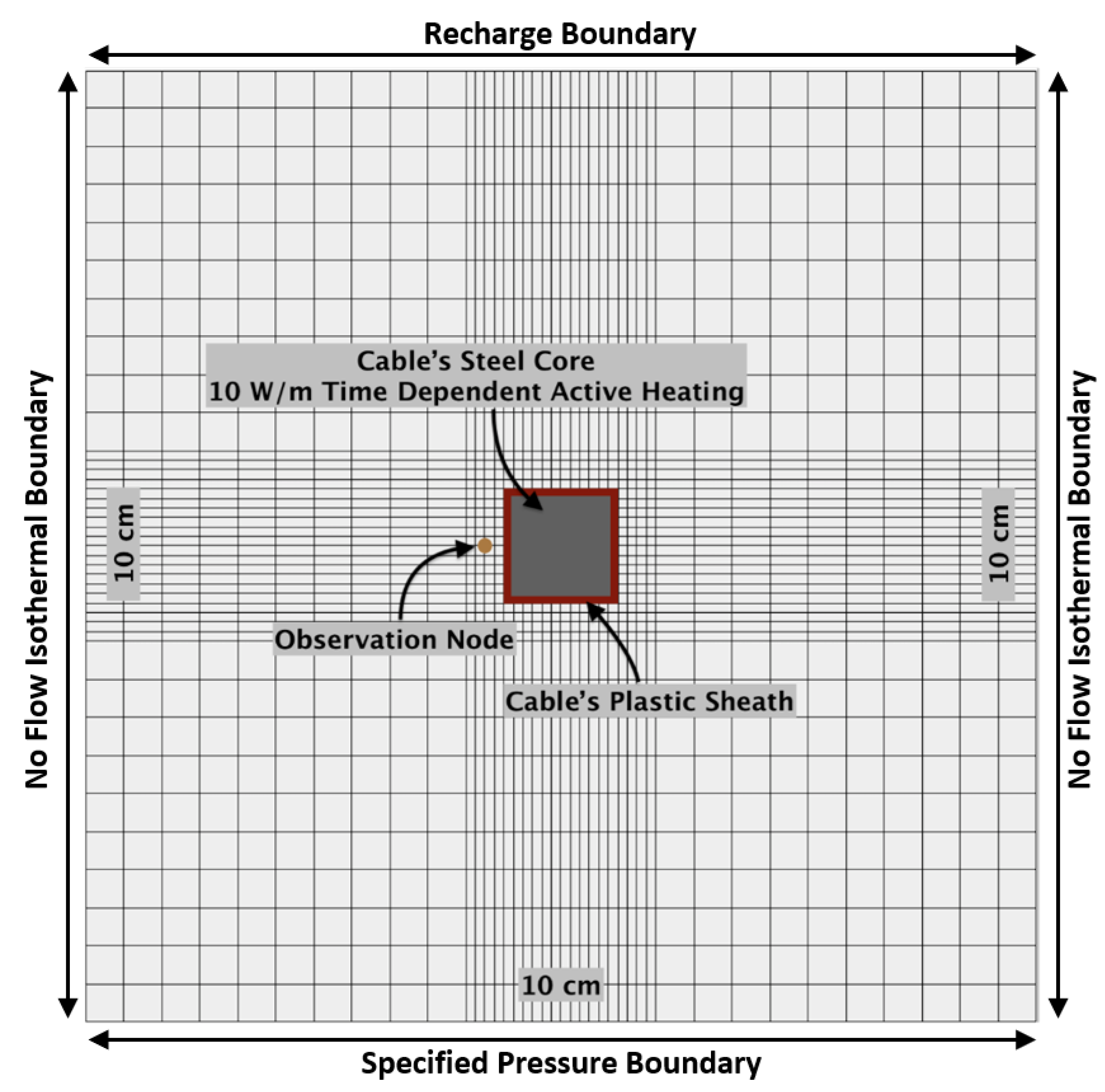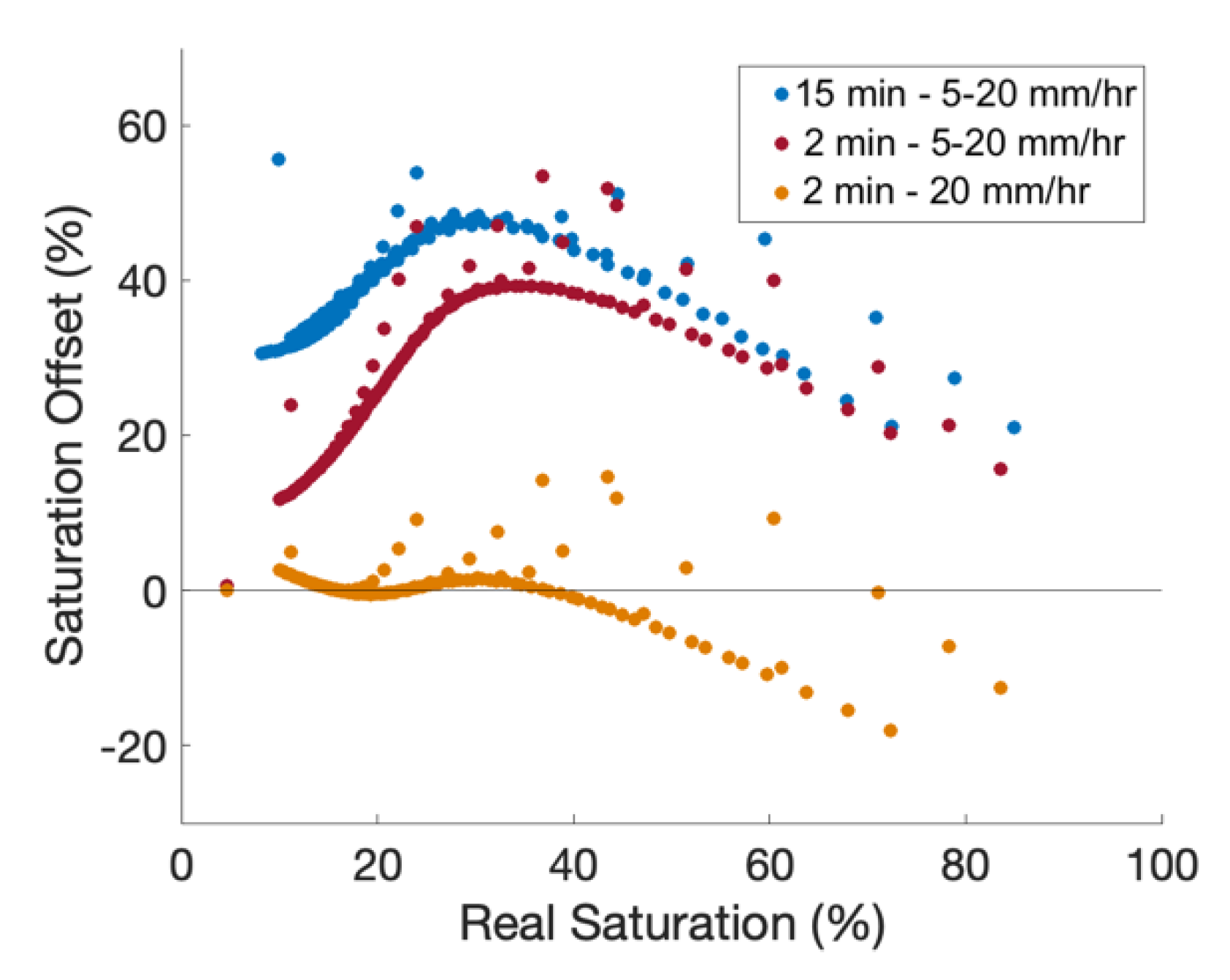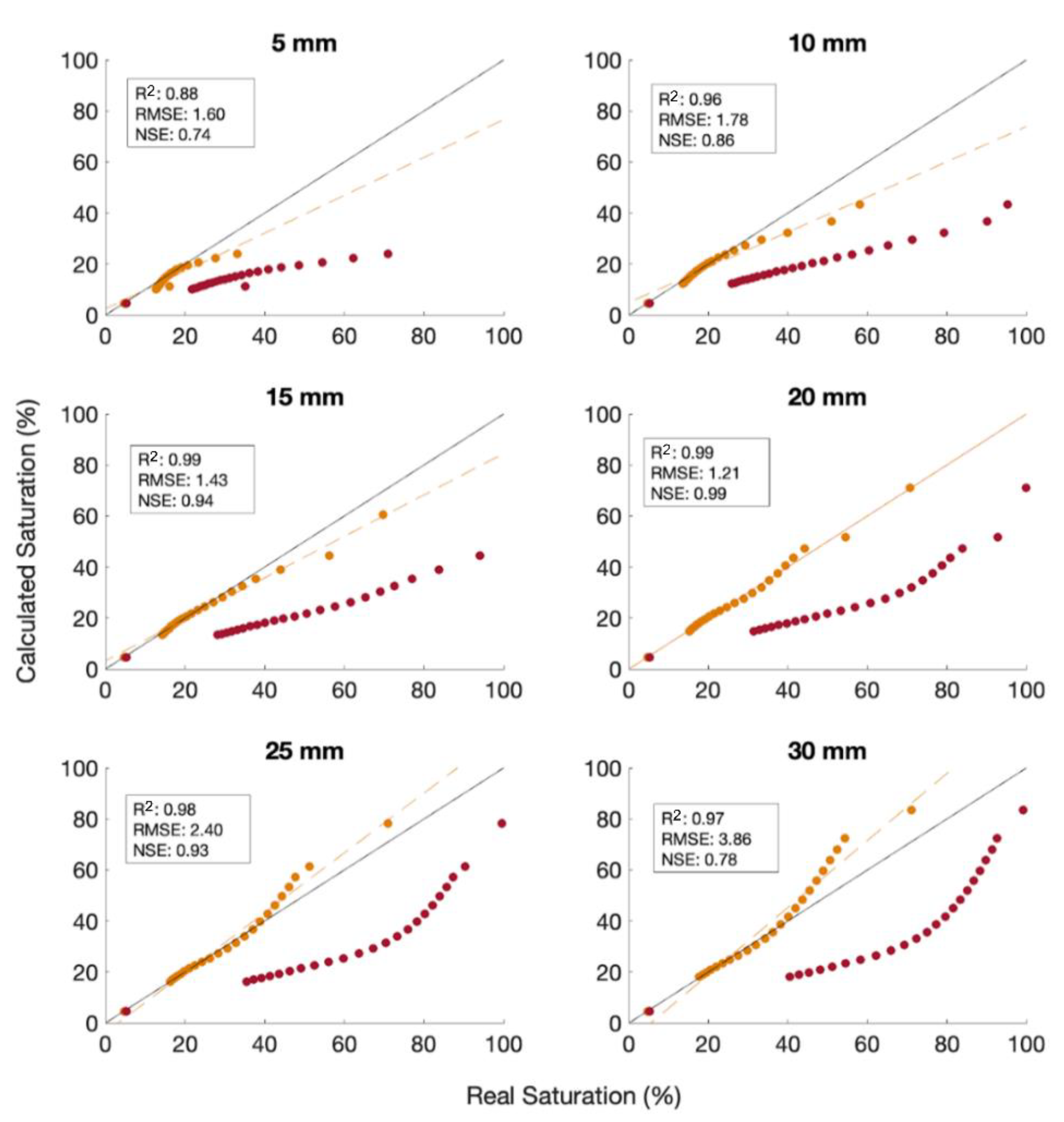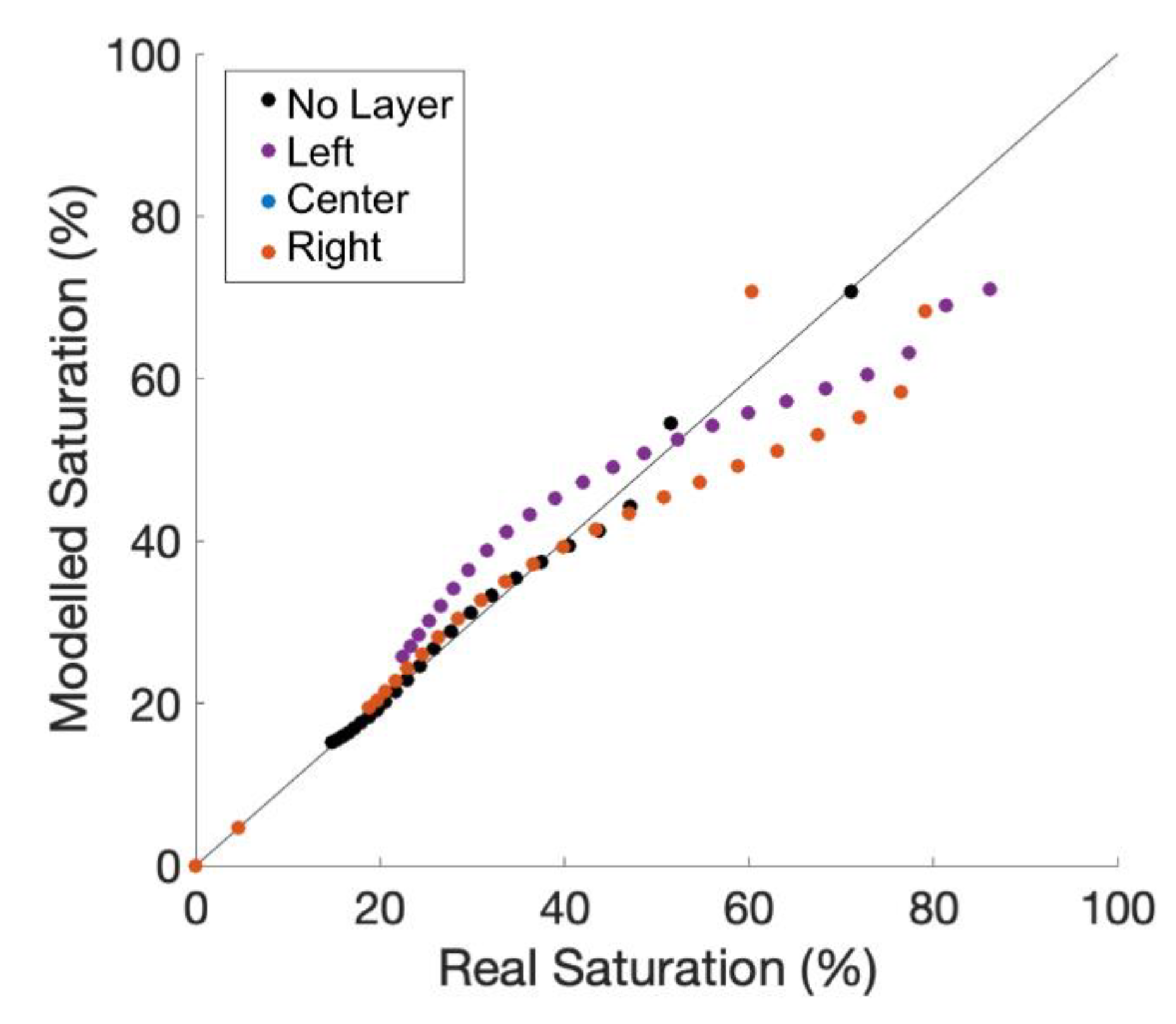Uncertainties in Measuring Soil Moisture Content with Actively Heated Fiber-Optic Distributed Temperature Sensing
Abstract
1. Introduction
- Model calibration curves based on field samples with different soil water contents. For example, Benítez-Buelga et al. [19] collected undisturbed field samples and measured the thermal properties of the samples under varying soil saturation conditions to create a calibration function. The calibration function was used in a heat transport model to generate another calibration function relating Tcum to soil saturation for the specific soil in the study.
- Field generated calibration curves based on soil saturation probe data. For example, Cao et al. [25] generated calibration curves relating the thermal response of an aFO-DTS experiment to soil saturation content measured by soil saturation probes installed next to defined sections of the heated fiber-optic cable.
- Laboratory generated curves based on soil columns. For example, Wu et al. [26] constructed a soil column with integrated fiber-optic cable. The water table in the column was controlled to impose different soil saturation conditions inside the soil column. The calibration curve relating Tcum to soil saturation was obtained by fitting a curve to the Tcum-soil saturation content collocated measurements.
2. Methods
2.1. Numerical Thermo-Hydrogeologic Model
2.2. Modifications Made to the Model
2.3. Model Setup
2.3.1. Domain and Mesh
2.3.2. Boundary Conditions
2.4. Calibration Curves
- The initial pressure of these simulations is set to −65,000 Pa.
- Gravity is set to 9.81 m/s2 to allow vertical flow.
- The top hydraulic boundary condition was changed to a constant specified recharge for 15 min or 2 min heat pulses. As described below, the recharge rates were calculated to provide the model with enough water to reach the total saturation levels tested previously in the static simulations (10% increments).
2.5. Protocol Evaluation
2.6. Model Scenarios
2.6.1. Static Water with 10% Saturation Increments to Build Calibration Curve
2.6.2. Static Calibration with Varying Water Temperature and Continuous Heat Pulses
2.6.3. 5 mm to 30 mm Recharge Events—15 min Flowing Water Calibration
2.6.4. 5 mm to 30 mm Recharge Events—2 min Flowing Water Calibration
2.6.5. 5 mm to 30 mm Recharge Events—2 min, 20 mm/hr Flowing Water Calibration
2.6.6. Varying Recharge Duration and Soil Heterogeneity
2.6.7. Soil Heterogeneity
3. Results and Discussion
3.1. Static Simulations
3.2. Simulations with 15 Min Calibration and Recharge
3.3. Simulations with 2 Min Calibrations
3.4. Simulations with Variable Recharge and Heterogeneous Soil Conditions
3.5. Simulations with Spatially Variability of Permeability
4. Conclusions
Author Contributions
Funding
Institutional Review Board Statement
Informed Consent Statement
Data Availability Statement
Acknowledgments
Conflicts of Interest
References
- Brocca, L.; Melone, F.; Moramarco, T.; Morbidelli, R. Spatial-temporal variability of soil moisture and its estimation across scales. Water Resour. Res. 2010, 46. [Google Scholar] [CrossRef]
- Amin, A.; Zuecco, G.; Geris, J.; Schwendenmann, L.; McDonnell, J.J.; Borga, M.; Penna, D. Depth distribution of soil water sourced by plants at the global scale: A new direct inference approach. Ecohydrology 2020, 13. [Google Scholar] [CrossRef]
- Hausner, M.B. Estimating in Situ Integrated Soil Moisture Content Using Fiber-Optic Distributed Temperature Sensing (DTS) Measurements in the Field. Ph.D. Thesis, University of Nevada, Reno, NV, USA, 2010. [Google Scholar]
- Scanlon, B.R.; Healy, R.W.; Cook, P.G. Choosing appropriate techniques for quantifying groundwater recharge. Hydrogeol. J. 2002, 10, 18–39. [Google Scholar] [CrossRef]
- Tyler, S.W.; Wheatcraft, S.W. Application of fractal mathematics to soil water retention estimation. Soil Sci. Soc. Am. J. 1989, 53, 987–996. [Google Scholar] [CrossRef]
- Wu, R.; Martin, V.; McKenzie, J.M.; Broda, S.; Bussière, B.; Selker, J.; Aubertin, M. Fiber optic measurements of soil moisture in a waste rock pile. Groundwater 2021. [Google Scholar] [CrossRef] [PubMed]
- Dorigo, W.A.; Wagner, W.; Hohensinn, R.; Hahn, S.; Paulik, C.; Drusch, M.; Mecklenburg, S.; van Oevelen, P.; Robock, A.; Jackson, T. The international soil moisture network: A data hosting facility for global in situ soil moisture measurements. Hydrol. Earth Syst. Sci. 2011, 15, 1675–1698. [Google Scholar] [CrossRef]
- Wigmore, O.; Mark, B.; McKenzie, J.M.; Baraer, M.; Lautz, L. Sub-metre mapping of surface soil moisture in proglacial valleys of the tropical andes using a multispectral unmanned aerial vehicle. Remote. Sens. Environ. 2019, 222, 104–118. [Google Scholar] [CrossRef]
- Striegl, A.M.; Loheide, S.P., II. Heated distributed temperature sensing for field scale soil moisture monitoring. Groundwater 2012, 50, 340–347. [Google Scholar] [CrossRef]
- Selker, J.; van de Giesen, N.; Westhoff, M.; Luxemburg, W.; Parlange, M.B. Fiber optics opens window on stream dynamics. Geophys. Res. Lett. 2006, 33. [Google Scholar] [CrossRef]
- Grattan, K.T.V.; Sun, T. Fiber optic sensor technology: An overview. Sens. Actuators Phys. 2000, 82, 40–61. [Google Scholar] [CrossRef]
- Ciocca, F.; Lunati, I.; de Giesen, N.V.; Parlange, M.B. Heated optical fiber for distributed soil-moisture measurements: A lysimeter experiment. Vadose Zone J. 2011, 11, vzj2011.0199. [Google Scholar] [CrossRef]
- Briggs, M.A.; Lautz, L.K.; McKenzie, J.M. A comparison of fibre-optic distributed temperature sensing to traditional methods of evaluating groundwater inflow to streams. Hydrol. Process. 2012, 26, 1277–1290. [Google Scholar] [CrossRef]
- Sayde, C.; Gregory, C.; Gil-Rodriguez, M.; Tufillaro, N.; Tyler, S.; van de Giesen, N.; English, M.; Cuenca, R.; Selker, J.S. Feasibility of soil moisture monitoring with heated fiber optics. Water Resour. Res. 2010, 46. [Google Scholar] [CrossRef]
- Bao, Y.; Huang, Y.; Hoehler, M.S.; Chen, G. Review of fiber optic sensors for structural fire engineering. Sens. Basel. Switz. 2019, 19, 877. [Google Scholar] [CrossRef]
- e Silva, M.S.P.; de Barros, T.H.C.; Alves, H.P.; do Nascimento, J.F.; Filho, J.F.M. Evaluation of fiber optic raman scattering distributed temperature sensor between −196 and 400 °C. IEEE Sens. J. 2021, 21, 1527–1533. [Google Scholar] [CrossRef]
- Bense, V.F.; Read, T.; Bour, O.; Borgne, T.L.; Coleman, T.; Krause, S.; Chalari, A.; Mondanos, M.; Ciocca, F.; Selker, J.S. Distributed temperature sensing as a downhole tool in hydrogeology. Water Resour. Res. 2016, 52, 9259–9273. [Google Scholar] [CrossRef]
- Law, R.; Christoffersen, P.; Hubbard, B.; Doyle, S.H.; Chudley, T.R.; Schoonman, C.M.; Bougamont, M.; des Tombe, B.; Schilperoort, B.; Kechavarzi, C.; et al. Thermodynamics of a fast-moving greenlandic outlet glacier revealed by fiber-optic distributed temperature sensing. Sci. Adv. 2021, 7, eabe7136. [Google Scholar] [CrossRef] [PubMed]
- Benítez-Buelga, J.; Rodríguez-Sinobas, L.; Calvo, R.S.; Gil-Rodríguez, M.; Sayde, C.; Selker, J.S. Calibration of soil moisture sensing with subsurface heated fiber optics using numerical simulation. Water Resour. Res. 2016, 52, 2985–2995. [Google Scholar] [CrossRef]
- Weiss, J.D. Using fiber optics to detect moisture intrusion into a landfill cap consisting of a vegetative soil barrier. J. Air Waste Manag. 2003, 53, 1130–1148. [Google Scholar] [CrossRef] [PubMed]
- Dong, J.; Steele-Dunne, S.C.; Ochsner, T.E.; van de Giesen, N. Determining soil moisture and soil properties in vegetated areas by assimilating soil temperatures. Water Resour. Res. 2016, 52, 4280–4300. [Google Scholar] [CrossRef]
- Pinder, G.F.; Celia, M.A. Subsurface Hydrology; John Wiley & Sons, Inc.: New York, NY, USA, 2006. [Google Scholar] [CrossRef]
- De Vries, D.A. A nonstationary method for determining thermal conductivity of a soil in situ. Soil Sci. 1952, 73, 83–90. [Google Scholar] [CrossRef]
- Sourbeer, J.J.; Loheide, S.P. Obstacles to long-term soil moisture monitoring with heated distributed temperature sensing. Hydrol. Process. 2016, 30, 1017–1035. [Google Scholar] [CrossRef]
- Cao, D.; Shi, B.; Loheide, S.P.; Gong, X.; Zhu, H.-H.; Wei, G.; Yang, L. Investigation of the influence of soil moisture on thermal response tests using active distributed temperature sensing (A–DTS) technology. Energ. Build. 2018, 173, 239–251. [Google Scholar] [CrossRef]
- Wu, R.; Martin, V.; McKenzie, J.M.; Broda, S.; Bussière, B.; Aubertin, M.; Kurylyk, B.L. Laboratory scale assessment of a capillary barrier using fibre optic distributed temperature sensing (FO-DTS). Can. Geotech. J. 2020, 57, 115–126. [Google Scholar] [CrossRef]
- Voss, C.I.; Provost, A.M. SUTRA: A Model for 2D or 3D Saturated-Unsaturated, Variable-Density Ground-Water Flow with Solute or Energy Transport; Water-Resources Investigations Report 2002-4231; U.S. Geological Survey: Reston, VA, USA, 2002; p. 250.
- van Genuchten, M.T. A Closed-form equation for predicting the hydraulic conductivity of unsaturated soils. Soil Sci. Soc. Am. J. 1980, 44, 892–898. [Google Scholar] [CrossRef]
- Deeds, N.E.; Jones, T.L. An Assessment of Modeling Approaches to Brackish Aquifers in Texas; Final Report; Texas Water Development Board: Austin, TX, USA, 2011; p. 141.
- Bobba, A.G. Field validation of ‘SUTRA’ groundwater flow model to Lambton county, Ontario, Canada. Water Resour. Manag. 1993, 7, 289–310. [Google Scholar] [CrossRef]
- Woods, J.A.; Teubner, M.D.; Simmons, C.T.; Narayan, K.A. Numerical error in groundwater flow and solute transport simulation. Water Resour. Res. 2003, 39. [Google Scholar] [CrossRef]
- Gingerich, S.B.; Voss, C.I. Three-dimensional variable-density flow simulation of a coastal aquifer in southern Oahu, Hawaii, USA. Hydrogeol. J. 2005, 13, 436–450. [Google Scholar] [CrossRef]
- Smith, A.J. Mixed convection and density-dependent seawater circulation in coastal aquifers. Water Resour. Res. 2004, 40. [Google Scholar] [CrossRef]
- Kurylyk, B.L.; MacQuarrie, K.T.B.; Voss, C.I. Climate Change impacts on the temperature and magnitude of groundwater discharge from shallow, unconfined aquifers. Water Resour. Res. 2014, 50, 3253–3274. [Google Scholar] [CrossRef]
- Oki, D.S.; Engott, J.A.; Rotzoll, K. Numerical Simulation of Groundwater Availability in Central Moloka‘i, Hawai‘i; Scientific Investigations Report 2019-5150; U.S. Geological Survey: Reston, VA, USA, 2020; p. 95.
- Burns, E.R.; Williams, C.F.; Ingebritsen, S.E.; Voss, C.I.; Spane, F.A.; DeAngelo, J. Understanding heat and groundwater flow through continental flood basalt provinces: Insights Gained from alternative models of permeability/depth relationships for the Columbia plateau, USA. Geofluids 2015, 15, 120–138. [Google Scholar] [CrossRef]
- Burns, E.R.; Bershaw, J.; Williams, C.F.; Wells, R.; Uddenberg, M.; Scanlon, D.; Cladouhos, T.; van Houten, B. Using saline or brackish aquifers as reservoirs for thermal energy storage, with example calculations for direct-use Heating in the Portland Basin, Oregon, USA. Geothermics 2020, 88, 101877. [Google Scholar] [CrossRef]
- Lamontagne-Hallé, P.; McKenzie, J.M.; Kurylyk, B.L.; Zipper, S.C. Changing groundwater discharge dynamics in permafrost regions. Environ. Res. Lett. 2018, 13, 084017. [Google Scholar] [CrossRef]
- Buntebarth, G.; Schopper, J.R. Experimental and theoretical investigations on the influence of fluids, solids and interactions between them on thermal properties of porous rocks. Phys. Chem. Earth 1998, 23, 1141–1146. [Google Scholar] [CrossRef]
- Xie, X.; Lu, Y.; Ren, T.; Horton, R. Thermal conductivity of mineral soils relates linearly to air-filled porosity. Soil Sci. Soc. Am. J. 2020, 84, 53–56. [Google Scholar] [CrossRef]
- Dimech, A.; Chouteau, M.; Aubertin, M.; Bussière, B.; Martin, V.; Plante, B. Three-dimensional time-lapse geoelectrical monitoring of water infiltration in an experimental mine waste rock pile. Vadose Zone J. 2019, 18, 1–19. [Google Scholar] [CrossRef]
- Nash, J.E.; Sutcliffe, J.V. River flow forecasting through conceptual models part I—A discussion of principles. J. Hydrol. 1970, 10, 282–290. [Google Scholar] [CrossRef]
- Beven, K.; Germann, P. Macropores and water flow in soils. Water Resour. Res. 1982, 18, 1311–1325. [Google Scholar] [CrossRef]









| Default Parameters | Value |
|---|---|
| Sand | |
| Porosity | 0.44 |
| Specific Heat of solid (J/kg°C) | 840 |
| Thermal Conductivity of solid (J/sm°C) | 3.5 |
| Absolute Permeability (m2) | 10−12 |
| Residual Saturation | 0.045 |
| Air Entry Value ((kg/(s2 m))−1) | 0.00035 |
| Pore Size Distribution | 3.19 |
| Density of solid (kg/m3) | 2600 |
| Soil Characteristic Curve (van Genuchten Type [27,28]) | |
| Residual Saturation | 0.045 |
| Alpha | 0.00035 |
| VN | 3.19 |
| Cable Plastic Sheath | |
| Porosity | 0.001 |
| Specific Heat (J/kg°C) | 1.67 |
| Thermal Conductivity (J/sm°C) | 0.026 |
| Permeability (m2) | 10−90 |
| Cable Steel | |
| Porosity | 0.001 |
| Specific Heat (J/kg°C) | 502 |
| Thermal Conductivity (J/sm°C) | 13.389 |
| Permeability (m2) | 10−90 |
| Energy Source (J/s) | 10 |
| Additional SUTRA Parameters | |
| Water Specific Heat (J/kg°C) | 4182 |
| Water Thermal Conductivity (J/sm°C) | 0.6 |
| Water Compressibility ((kg/(s2 m))−1) | 4.47 × 10−10 |
| Longitudinal and Transverse Dispersity | 0.5 |
| Air Thermal Conductivity (J/sm°C) | 0.025 |
| Scenarios | Gravity (m/s2) | Initial Temp (°C) | Saturation Comparison | Heat Pulse Duration (min) | Number of Hourly Cycles | Testing Specific Saturation or Time Series | Calibration | Range of Recharge Rate Used (mm/hr) |
|---|---|---|---|---|---|---|---|---|
| Static Calibration, Default | 0 | 20 | % of Water Specified in Pores | 15 | 1 | Saturation (R2) | 15 min static | 0 |
| Static Calibration, Low Initial Temp | 0 | 10, 5 | % of Water Specified in Pores | 15 | 1 | Saturation (R2) | 15 min static | 0 |
| Static Calibration, 24 Heat Pulses | 0 | 20 | Observation Node | 15 | 24 | Saturation (R2) | 15 min static | 0 |
| 15 min Flowing Water Calibration | 9.81 | 20 | Observation Node | 15 | 24 | Time Series (NSE) | 15 min flow | 5–30 |
| 2 min Flowing Water Calibration | 9.81 | 20 | Observation Node | 2 | 24 | Time Series (NSE) | 2 min flow | 5–30 |
| 2 min–20 mm /hr Flowing Water Calibration | 9.81 | 20 | Observation Node | 2 | 24 | Time Series (NSE) | 2 min flow specified for 20 mm/hr | 5–30 |
| Permeability Heterogeneity | 9.81 | 20 | Observation Node | 2 | 24 | Time Series (NSE) | 2 min flow specified for 20 mm/hr | 5–30 |
| Macropore | 9.81 | 20 | Observation Node | 2 | 24 | Time Series (NSE) | 2 min flow specified for 20 mm/hr | 5–30 |
| Permeability Surrounding Cable | 9.81 | 20 | Observation Node | 2 | 24 | Time Series (NSE) | 2 min flow specified for 20 mm/hr | 5–30 |
| Overlying Low Permeability Layer | 9.81 | 20 | Observation Node | 2 | 24 | Time Series (NSE) | 2 min flow specified for 20 mm/hr | 5–30 |
| Recharge Duration | 9.81 | 20 | Observation Node | 2 | 24 | Time Series (NSE) | 2 min flow specified for 20 mm/hr | 20 |
Publisher’s Note: MDPI stays neutral with regard to jurisdictional claims in published maps and institutional affiliations. |
© 2021 by the authors. Licensee MDPI, Basel, Switzerland. This article is an open access article distributed under the terms and conditions of the Creative Commons Attribution (CC BY) license (https://creativecommons.org/licenses/by/4.0/).
Share and Cite
Wu, R.; Lamontagne-Hallé, P.; McKenzie, J.M. Uncertainties in Measuring Soil Moisture Content with Actively Heated Fiber-Optic Distributed Temperature Sensing. Sensors 2021, 21, 3723. https://doi.org/10.3390/s21113723
Wu R, Lamontagne-Hallé P, McKenzie JM. Uncertainties in Measuring Soil Moisture Content with Actively Heated Fiber-Optic Distributed Temperature Sensing. Sensors. 2021; 21(11):3723. https://doi.org/10.3390/s21113723
Chicago/Turabian StyleWu, Robert, Pierrick Lamontagne-Hallé, and Jeffrey M. McKenzie. 2021. "Uncertainties in Measuring Soil Moisture Content with Actively Heated Fiber-Optic Distributed Temperature Sensing" Sensors 21, no. 11: 3723. https://doi.org/10.3390/s21113723
APA StyleWu, R., Lamontagne-Hallé, P., & McKenzie, J. M. (2021). Uncertainties in Measuring Soil Moisture Content with Actively Heated Fiber-Optic Distributed Temperature Sensing. Sensors, 21(11), 3723. https://doi.org/10.3390/s21113723






